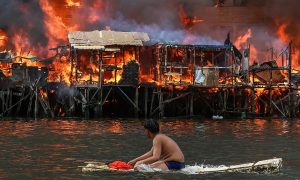[img_gallery][/img_gallery]
Over the last century, Tibet has attracted adventurers and those seeking spirituality. With her husband and three children, Michele Chan-Thomson set off to learn first-hand about this remote area and its people.
As our journey begins, I realize I do not know much about Tibet other than miscellaneous quotes attributed to the Dalai Lama and reading James Hilton’s novel, Lost Horizon, decades ago. As we fly in, snowcapped mountains and towering peaks spread out beneath us. Hugh Conway may have found inner peace at Lost Horizon’s Shangri-La, but first he had to crash in the Himalayas. What adventures are ahead for our visit to the Roof of the World?
See Also: An Expat’s Journey to Nepal
We safely land outside of Lhasa, the capital of Tibet, and I am immediately struck by the sky’s brilliant, blue shade that I never see in Penang. The air is crisp, clean, and a comfortable, cool temperature that requires only a jacket in the afternoon. Poplar trees with golden hued leaves line the river, and mountains rise up beside the valley. Colorful prayer flags strung across bridges and fluttering atop homes spread goodwill and compassion across the land according to Tibetan beliefs. I can see why the region’s rugged beauty and prolifi c spirituality draws people here.
Exploring Spiritual Tourism
Lhasa means “place of the gods” and has been the center of Tibetan Buddhism for centuries. In late October, most Western and Chinese tourists have left for the season. With the harvest finished, the majority of the visitors are Tibetan farmers.
A crowd of pilgrims flows past us as we explore the Potala Palace which served as a home and administrative center for Dalai Lamas starting in the 7th century. Spinning prayer wheels and muttering mantras, Tibetans with weathered faces shuffle clockwise around the thousand-room, 13-stories-high palace towering above us.
Barkhor Street surrounds Jokhang Temple, the holiest Buddhist site in Tibet. Pilgrims also perform the clockwise circuit here and prostrate themselves in supplication at the temple’s entrance plaza. Afterwards, they stop at market stalls to purchase yak butter, yak meat, barley, and other goods.
Nearby Norbulingka Palace and its parkland were established in the 18th century as the Dalai Lama’s summer home where each successor built his own residence. The most popular place for Tibetans to take photographs is where the current Dalai Lama lived before going into exile in India during the 1959 Tibetan Uprising against China. They clearly still revere their head monk.
At Sera Monastery, crowds gather to watch student monks participate in a curiously percussive debate. They gesture vigorously and loudly clap in each other’s faces, keeping visitors engaged even if we do not understand a word.
Located 90 minutes from Lhasa, Ganden Monastery was destroyed by China while quelling the 1959 Uprising and again in 1966. Tibetans are slowly reconstructing it. We witness monks and locals whitewashing buildings or applying fresh coats of red and saffron paint now that rainy season is over. Inside assembly halls, butter candles burn near gilded Buddha statues, and monks stand ready to bless the faithful. The view of the monastery set high atop the mountain with russet colored trees cascading down the slope to the flat valley far below is not to be missed.
Struggling for a Free Tibet
“Do not mention Tibet when applying for your China visa,” my travel agent told us. That was my first hint at the tensions between Chinese rule and Tibetans longing to be independent.
Bringing water into Potala Palace is prohibited. I initially thought it was a “No Outside Food or Drink” policy. Instead, it guards against Tibetans bringing awareness to their struggle for freedom by sneaking in fuel to set themselves afi re. More than 100 people have died in this form of protest over the last four years.
With an eye on the lucrative tourism industry, China is attempting to stifl e dissent without scaring away visitors. Lhasa, the site of major rioting in 2008, is a particularly sensitive area. Chinese guards are stationed throughout the city. Security checkpoints are located at tourist spots and along roads. Outside Lhasa, my husband and I had to get out of the car to have our passports checked and one bag scanned, but they permitted the kids and the rest of our backpacks to remain in the car. Strangely, no one monitors most X-ray scanners. Putting bags through seems to be a pointless procedure.
Biking to Everest Base Camp
In stark contrast to our leisurely explorations, Penang expats Laurel and Tim Stelzer cycled from Lhasa to Kathmandu, Nepal a few years ago. Biking up to Everest Base Camp and descending on the world’s longest downhill ride were some of the exhilarating challenges they faced. By traversing as much as 95.5 kilometers a day and crossing six mountain passes higher than 5,000 meters, they covered the distance in 19 days. Some rides were spent battling wind, cold, and hail along the steep terrain whereas on other days, they enjoyed autumnal weather and the flat Tibetan plateau. Their days were spent on grueling rides, but Red Spokes Cycling Adventure Holidays pampered them by pitching tents before they arrived at camp and keeping them well fed.
Suffering from Altitude Sickness
Altitude sickness hits most visitors to Tibet. When I see the Oxygen Shop at the airport, I think it is for those bound for Everest. By the second day, we discover that hand-held oxygen canisters relieve mere sightseers, too. Shortness of breath, rapid heart rate, lethargy, vomiting, appetite loss, dizziness, and headaches are symptoms. My daughter never acclimates during our entire stay. Our guide gives us a few tips to handle altitude sickness.
• Spend your arrival day resting and getting used to the elevation
• Drink plenty of water
• Avoid alcohol and caffeine
• Take deep, slow breaths
• Eat light meals high in carbohydrates
• Go to a hospital if your symptoms are getting extreme. It could be life threatening.
Visit Tibet
Tourism in Lhasa has risen by 20% in the last year. Hotels ranging from budget to luxury accommodations are being built, and some say that the area is starting to lose
its mystique. While I arrived with nothing more than vague notions, I depart with a deeper understanding of life in Tibet and their resiliency under China’s watchful eye.
Visas and Tours
First, obtain a China visa. Do not mention Tibet when applying. Next, apply for a Tibet Travel Permit from a travel agent registered with the Tibet Tourism Bureau. You must be accompanied by a guide. Travel into restricted areas requires an Alien Travel Permit. To enter from Nepal, obtain a visa in Kathmandu. Journalists and government officials are subject to a more stringent application process. China occasionally closes Tibet to foreign visitors.
If you would like to follow Michele’s adventures in Penang and around the world, read her blog, Malaysian Meanders (malaysianmeanders.blogspot.com).
Source: Penang International February/March 2014
Read More Travel Articles:
- High Altitude Adventure – Touring Nepal
- A Walking Tour of Melaka’s Heritage Area
- 10 Islands You Want to Visit in Malaysia
What are your thoughts on this article? Let us know by commenting below.No registration needed.
"ExpatGo welcomes and encourages comments, input, and divergent opinions. However, we kindly request that you use suitable language in your comments, and refrain from any sort of personal attack, hate speech, or disparaging rhetoric. Comments not in line with this are subject to removal from the site. "



















